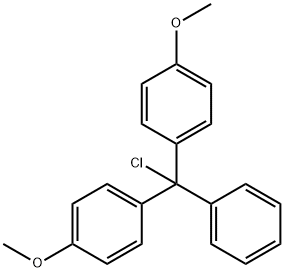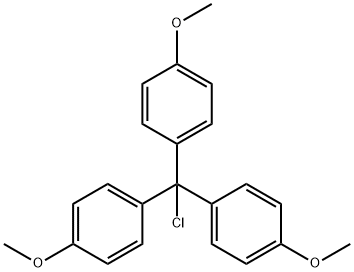4-Methoxytriphenylmethyl chloride
Synonym(s):p-Anisylchlorodiphenylmethane;p-Monomethoxytrityl chloride;4-Methoxytriphenylchloromethane;4-Methoxytrityl chloride;MMT
- CAS NO.:14470-28-1
- Empirical Formula: C20H17ClO
- Molecular Weight: 308.8
- MDL number: MFCD00000814
- EINECS: 238-463-8
- SAFETY DATA SHEET (SDS)
- Update Date: 2024-02-28 10:35:28

What is 4-Methoxytriphenylmethyl chloride?
Description
4-Methoxytriphenylmethyl chloride is an important organic intermediate compound, which can be used as an organic synthetic material or reaction reagent for the preparation of a group of cyclic polypeptide compounds, phosphoramidite nucleoside derivatives, nanomaterials and their antiviral drugs.
Chemical properties
PALE YELLOW TO YELLOW-BEIGE OR PINK CRYST. POWDER
The Uses of 4-Methoxytriphenylmethyl chloride
4-Methoxytriphenylmethyl chloride is used in the synthesis of N-sulfonyl imines.
The Uses of 4-Methoxytriphenylmethyl chloride
It is used as selective protecting reagent that is used for primary hydroxyl groups.
Hazard
Skin and eye irritant.
Properties of 4-Methoxytriphenylmethyl chloride
| Melting point: | 122-124 °C(lit.) |
| Boiling point: | 423.55°C (rough estimate) |
| Density | 1.0704 (rough estimate) |
| refractive index | 1.4530 (estimate) |
| storage temp. | 2-8°C |
| solubility | Soluble in toluene. |
| form | crystalline |
| color | off-white to pink |
| Sensitive | Moisture Sensitive |
| BRN | 798425 |
| CAS DataBase Reference | 14470-28-1(CAS DataBase Reference) |
| NIST Chemistry Reference | P-anisylchlorodiphenylmethane(14470-28-1) |
Safety information for 4-Methoxytriphenylmethyl chloride
| Signal word | Warning |
| Pictogram(s) |
 Exclamation Mark Irritant GHS07 |
| GHS Hazard Statements |
H315:Skin corrosion/irritation H319:Serious eye damage/eye irritation H335:Specific target organ toxicity, single exposure;Respiratory tract irritation |
| Precautionary Statement Codes |
P261:Avoid breathing dust/fume/gas/mist/vapours/spray. P264:Wash hands thoroughly after handling. P264:Wash skin thouroughly after handling. P280:Wear protective gloves/protective clothing/eye protection/face protection. P304+P340:IF INHALED: Remove victim to fresh air and Keep at rest in a position comfortable for breathing. P305+P351+P338:IF IN EYES: Rinse cautiously with water for several minutes. Remove contact lenses, if present and easy to do. Continuerinsing. P405:Store locked up. |
Computed Descriptors for 4-Methoxytriphenylmethyl chloride
Abamectin manufacturer
ChemGenes India Pvt Ltd
1Y
Phone:+91-8687421036
Whatsapp: +91-8687421036
product: 1-(Chloro-diphenyl-methyl)-4-methoxy-benzene 99%
Innovassynth Technologies (I) Ltd.
1Y
Phone:+91-7208872197
Whatsapp: +91- 7208872197
product: 1-(Chloro-diphenyl-methyl)-4-methoxy-benzene 14470-28-1 98%
New Products
4-Aminotetrahydropyran-4-carbonitrile Hydrochloride (R)-3-Aminobutanenitrile Hydrochloride 4-AMINO-TETRAHYDRO-PYRAN-4-CARBOXYLIC ACID HCL 4-(Dimethylamino)tetrahydro-2H-pyran-4-carbonitrile 3-((Dimethylamino)methyl)-5-methylhexan-2-one oxalate 1,4-Dioxa-8-azaspiro[4.5]decane 5-Bromo-2-nitropyridine Nimesulide BP Aceclofenac IP/BP/EP Diclofenac Sodium IP/BP/EP/USP Mefenamic Acid IP/BP/EP/USP Ornidazole IP Diclofenac Potassium SODIUM AAS SOLUTION ZINC AAS SOLUTION BUFFER SOLUTION PH 10.0(BORATE) GOOCH CRUCIBLE SINTERED AQUANIL 5 BERYLLIUM AAS SOLUTION 2-Bromo-1-(bromomethyl)-3-chloro-5-nitrobenzene 2-Bromo-3-nitroaniline N-(3-Hydroxypropyl)-N-methylacetamide 3-Bromo-6-chloropyridazine 4-ethyl-3-nitrobenzoic acidRelated products of tetrahydrofuran



![F17 DMT Cl, 1,1μ-{Chloro[4-(3,3,4,4,5,5,6,6,7,7,8,8,9,9,10,10,10-heptadecafluorodecyl)phenyl]methylene}-bis(4-methoxybenzene)](https://img.chemicalbook.in/CAS/GIF/865758-36-7.gif)
![1-CHLORO-2-(CHLORO[BIS(4-METHOXYPHENYL)]METHYL)BENZENE](https://img.chemicalbook.in/StructureFile/ChemBookStructure2/GIF/CB7369926.gif)
![1-(4-Methoxyphenyl)-1-[4-(1H,1H,2H,2H-perfluorodecyl)phenyl]-1-phenylmethyl Cl](https://img.chemicalbook.in/CAS/GIF/865758-37-8.gif)


You may like
-
 14470-28-1 4-Methoxytrityl chloride 98%View Details
14470-28-1 4-Methoxytrityl chloride 98%View Details
14470-28-1 -
 14470-28-1 99%View Details
14470-28-1 99%View Details
14470-28-1 -
 1-(Chloro-diphenyl-methyl)-4-methoxy-benzene 99%View Details
1-(Chloro-diphenyl-methyl)-4-methoxy-benzene 99%View Details
14470-28-1 -
 1-(Chloro-diphenyl-methyl)-4-methoxy-benzene 14470-28-1 98%View Details
1-(Chloro-diphenyl-methyl)-4-methoxy-benzene 14470-28-1 98%View Details
14470-28-1 -
 4-Anisylchloro diphenyl methane, 97% CAS 14470-28-1View Details
4-Anisylchloro diphenyl methane, 97% CAS 14470-28-1View Details
14470-28-1 -
![4-Methoxytrityl Chloride [Hydroxyl Protecting Agent] CAS 14470-28-1](https://img.chemicalbook.in//Content/image/CP5.jpg) 4-Methoxytrityl Chloride [Hydroxyl Protecting Agent] CAS 14470-28-1View Details
4-Methoxytrityl Chloride [Hydroxyl Protecting Agent] CAS 14470-28-1View Details
14470-28-1 -
 4-Methoxytriphenylmethyl chloride CAS 14470-28-1View Details
4-Methoxytriphenylmethyl chloride CAS 14470-28-1View Details
14470-28-1 -
 Lithium ClavulanateView Details
Lithium ClavulanateView Details
61177-44-4
Statement: All products displayed on this website are only used for non medical purposes such as industrial applications or scientific research, and cannot be used for clinical diagnosis or treatment of humans or animals. They are not medicinal or edible.